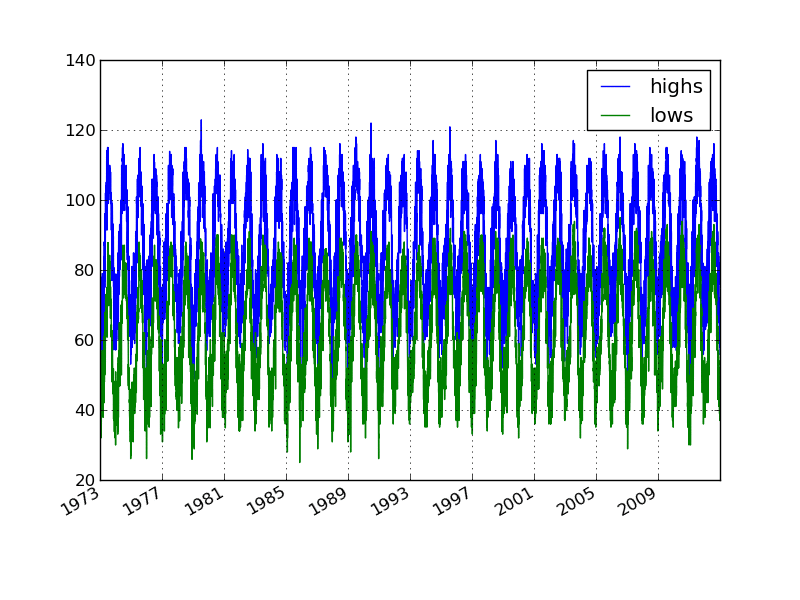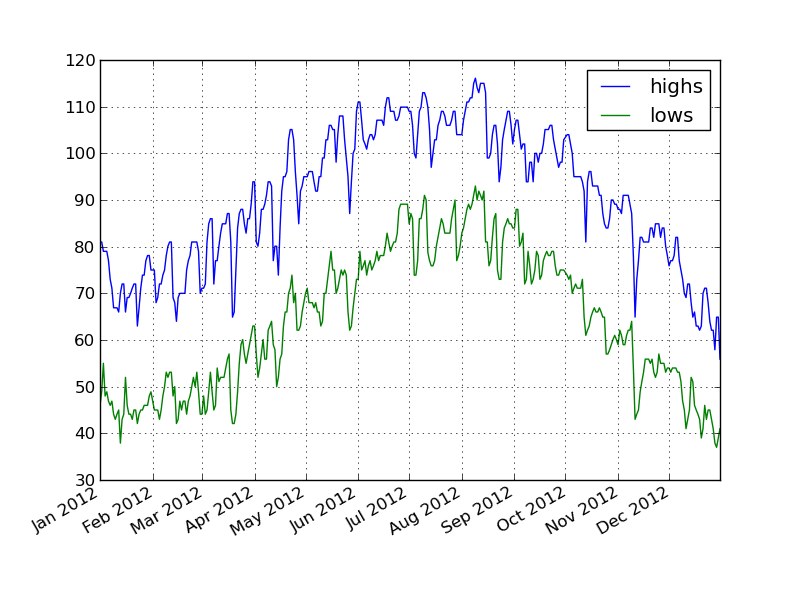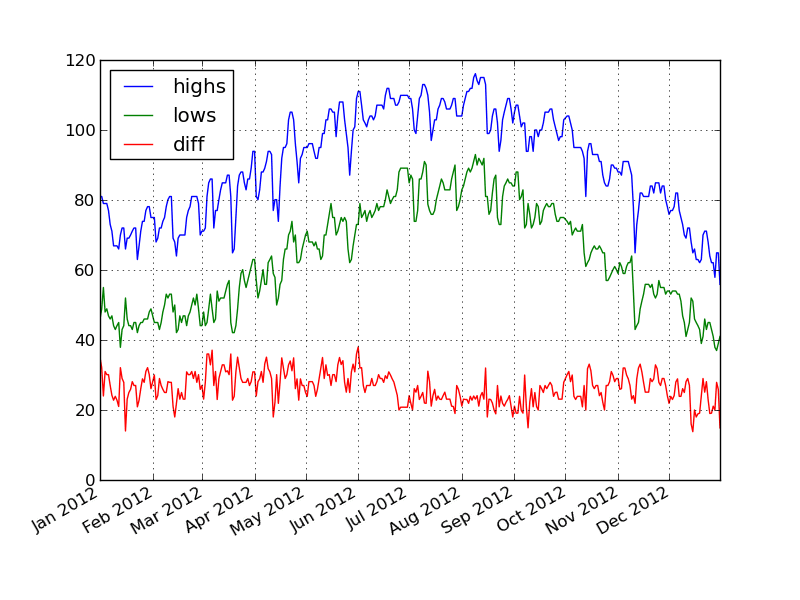Panda's Friends!
IPython
Numpy
Matplotlib

Pandas and Friends
Austin Godber
Mail: godber@uberhip.com
Twitter: @godber
Pandas is a Python data analysis tool built on top of NumPy that provides a suite of data structures and data manipulation functions to work on those data structures. It is particularly well suited for working with time series data.
Installing with pip or apt-get:
pip install pandas # or sudo apt-get install python-pandas
Mac - Homebrew or MacPorts to get the dependencies, then pip
Windows - Python(x,y)?, Commercial Pythons
IPython
Numpy
Matplotlib

Dependencies, required, recommended and optional
# Required numpy, python-dateutil, pytx # Recommended numexpr, bottleneck # Optional cython, scipy, pytables, matplotlib, statsmodels, openpyxl
IPython is a fancy python console. Try running ipython or ipython --pylab on your command line. Some IPython tips
# Special commands, 'magic functions', begin with % %quickref, %who, %run, %reset # Shell Commands ls, cd, pwd, mkdir # Need Help? help(), help(obj), obj?, function? # Tab completion of variables, attributes and methods
There is a web interface to IPython, known as the IPython notebook, start it like this
ipython notebook # or to get all of the pylab components ipython notebook --pylab
Follow along by connecting to one of these servers.
NOTE: Only active on presentation day.
NumPy is the foundation for Pandas
Numerical data structures (mostly Arrays)
Operations on those.
Less structure than Pandas provides.
import numpy as np # np.zeros, np.ones data0 = np.zeros((2, 4)) #array([[ 0., 0., 0., 0.], # [ 0., 0., 0., 0.]]) data1 = np.arange(100) #array([ 0, 1, 2, .. 99])
data = np.arange(20).reshape(4, 5)
#array([[ 0, 1, 2, 3, 4],
# [ 5, 6, 7, 8, 9],
# [10, 11, 12, 13, 14],
# [15, 16, 17, 18, 19]])
data.dtype #dtype('int64')
result = data * 20.5
#array([[ 0. , 20.5, 41. , 61.5, 82. ], ...
#dtype('float64')
Tabular, Timeseries, Matrix Data - labeled or not
Sensible handling of missing data and data alignment
Data selection, slicing and reshaping features
Robust data import utilities.
Advanced time series capabilities
Series - 1D labeled array
DataFrame - 2D labeled array
Panel - 3D labeled array (More D)
In my code samples, assume I import the following
import pandas as pd import numpy as np
See code/series_ex1.py for python source from which the next slides were derived.
one-dimensional labeled array
holds any data type
axis labels known asi index
dict-like
s1 = pd.Series([1, 2, 3, 4, 5]) # 0 1 # 1 2 # 2 3 # 3 4 # 4 5 # dtype: int64
print s1 * 5 # 0 5 # 1 10 # 2 15 # 3 20 # 4 25 # dtype: int64
print s1 * 5.0 # 0 5 # 1 10 # 2 15 # 3 20 # 4 25 # dtype: float64
s2 = pd.Series([1, 2, 3, 4, 5],
index=['a', 'b', 'c', 'd', 'e'])
# a 1
# b 2
# c 3
# d 4
# e 5
# dtype: int64A quick aside ...
dates = pd.date_range('20130626', periods=5)
# <class 'pandas.tseries.index.DatetimeIndex'>
# [2013-06-26 00:00:00, ..., 2013-06-30 00:00:00]
# Length: 5, Freq: D, Timezone: None
dates[0]
# <Timestamp: 2013-06-26 00:00:00>s3 = pd.Series([1, 2, 3, 4, 5], index=dates) # 2013-06-26 1 # 2013-06-27 2 # 2013-06-28 3 # 2013-06-29 4 # 2013-06-30 5 # Freq: D, dtype: int64
Note that the integer index is retained along with the new date index.
s3[0] # 1 s3[1:3] # 2013-06-27 2 # 2013-06-28 3 # Freq: D, dtype: int64
s3[s3 < 3] # 2013-06-26 1 # 2013-06-27 2 # Freq: D, dtype: int64
s3['20130626':'20130628'] # 2013-06-26 1 # 2013-06-27 2 # 2013-06-28 3 # Freq: D, dtype: int64
Things not covered but you should look into:
Other instantiation options: dict
Operator Handling of missing data NaN
Reforming Data and Indexes
Boolean Indexing
Other Series Attributes:
index - index.name
name - Series name
2-dimensional labeled data structure
Like a SQL Table, Spreadsheet or dict of Series objects.
Columns of potentially different types
Operations, slicing and other behavior just like Series
See code/dataframe_ex1.py for python source from which the next slides were derived.
data1 = pd.DataFrame(np.random.rand(4, 4)) # 0 1 2 3 # 0 0.748663 0.119829 0.382114 0.375031 # 1 0.549362 0.409125 0.336181 0.870665 # 2 0.102960 0.539968 0.356454 0.661136 # 3 0.233307 0.338176 0.577226 0.966152
dates = pd.date_range('20130626', periods=4)
data2 = pd.DataFrame(np.random.rand(4, 4),
index=dates, columns=list('ABCD'))
# A B C D
# 2013-06-26 0.538854 0.061999 0.099601 0.010284
# 2013-06-27 0.800049 0.978754 0.035285 0.383580
# 2013-06-28 0.761694 0.764043 0.136828 0.066216
# 2013-06-29 0.129422 0.756846 0.931354 0.380510See? You never need Excel again!
data2['E'] = data2['B'] + 5 * data2['C'] # A B C D E # 2013-06-26 0.014781 0.929893 0.402966 0.014548 2.944723 # 2013-06-27 0.968832 0.015926 0.976208 0.507152 4.896967 # 2013-06-28 0.381733 0.916911 0.828290 0.678275 5.058361 # 2013-06-29 0.447551 0.066915 0.308007 0.426910 1.606950
# Deleting a Column del data2['E'] # Column Access as a dict data2['B'] # or attribute data2.B
# by row label data2.loc['20130627'] # by integer location data2.iloc[1]
data3 = pd.DataFrame(np.random.rand(400, 4)) data2.head() # 0 1 2 3 # 0 0.245475 0.488223 0.624225 0.563708 # 1 0.237461 0.441690 0.162622 0.173519 data2.tail() # 0 1 2 3 # 398 0.474941 0.847748 0.682227 0.871416 # 399 0.414240 0.819523 0.234805 0.333394
Like DataFrame but 3 or more dimensions.
Robust IO tools to read in data from a variety of sources
Matplotlib - The standard Python plotting tool
Trellis - An 'R' inspired Matplotlib based plotting tool
The csv file (code/phx-temps.csv) containing Phoenix weather data from GSOD:
1973-01-01 00:00:00,53.1,37.9 1973-01-02 00:00:00,57.9,37.0 ... 2012-12-30 00:00:00,64.9,39.0 2012-12-31 00:00:00,55.9,41.0
# simple readcsv
phxtemps1 = pd.read_csv('phx-temps.csv')
# define index, parse dates, name columns
phxtemps2 = pd.read_csv('phx-temps.csv', index_col=0,
names=['highs', 'lows'],
parse_dates=True)import matplotlib.pyplot as plt
phxtemps2 = pd.read_csv('phx-temps.csv', index_col=0,
names=['highs', 'lows'],
parse_dates=True)
phxtemps2.plot() # pandas convenience method
plt.savefig('phxtemps2.png')

Boo, Pandas and Friends would cry if they saw such a plot.
phxtemps2['20120101':'20121231'].plot()

phxtemps2['diff'] = phxtemps2.highs - phxtemps2.lows phxtemps2['20120101':'20121231'].plot()

AstroPy seems to have similar data structures.
I suspect there are others.
Presentation Source - https://github.com/desertpy/presentations